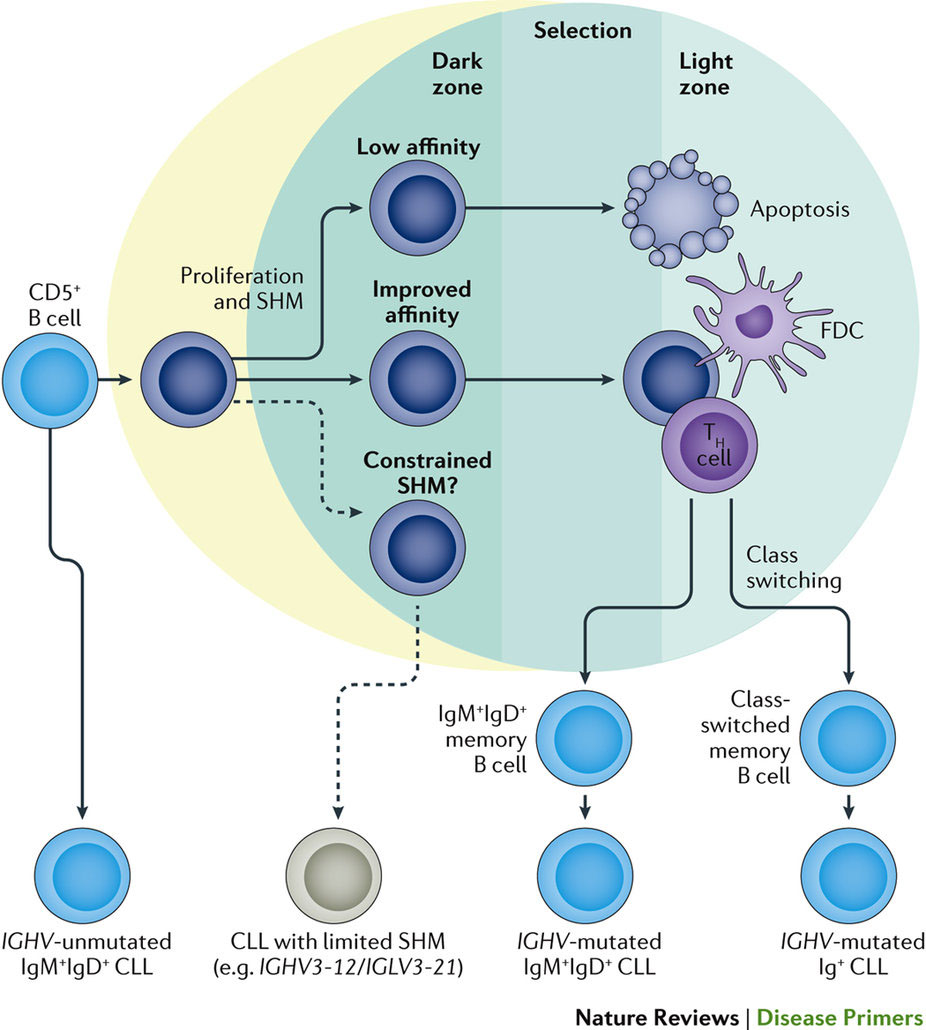慢性リンパ球性白血病
Chronic lymphocytic leukaemia
2017年1月19日 Nature Reviews Disease Primers Article number: 16096 (2017) doi: 10.1038/nrdp.2016.96

慢性リンパ球性白血病(CLL)はCD5+B細胞の悪性腫瘍であり、血液、骨髄およびリンパ組織への成熟小型リンパ球の蓄積を特徴としている。CLLの発症には、リンパ節内でのCLL細胞と、間質細胞、T細胞、ナース様細胞などのタイプの異なる細胞との相互作用だけでなく、B細胞受容体の主要構成因子である膜表面免疫グロブリンを介したシグナル伝達といくつかの遺伝子変異も部分的に関与している。CLLの臨床的進行は多様であり、診断後直ちに治療開始の必要がある患者もあれば、何年も治療を必要としない患者もある。管理戦略を最適化するためには、免疫グロブリン重鎖可変領域遺伝子(IGHV)の変異の状態、ゲノム変異、患者の年齢および併存疾患の有無など、いくつかの要因を考慮する必要があり、その上で、化学療法、化学免疫療法および/またはB細胞受容体シグナル伝達を標的とする薬剤またはアポトーシス阻害因子(BCL-2など)などが使用される。CLLの生物学的研究が進むと、疾患進行のリスクが高い患者の同定能ならびに特有の表現型または生理学的特性に選択的に働く薬剤を使用したCLL治療が大きく進歩した。このPrimerでは、このような進歩によってもたらされたCLLの病態の解明と治療法の現状について解説する。
PrimeView
慢性リンパ球性白血病(CLL)はB細胞の悪性腫瘍である。このPrimeViewでは、遺伝子変異、B細胞受容体シグナル伝達、腫瘍微小環境内の相互作用など、CLLの発症機構を中心に取りまとめる。
本Primerの図解サマリー
Chronic lymphocytic leukaemia (CLL) is a malignancy of CD5+ B cells that is characterized by the accumulation of small, mature-appearing lymphocytes in the blood, marrow and lymphoid tissues. Signalling via surface immunoglobulin, which constitutes the major part of the B cell receptor, and several genetic alterations play a part in CLL pathogenesis, in addition to interactions between CLL cells and other cell types, such as stromal cells, T cells and nurse-like cells in the lymph nodes. The clinical progression of CLL is heterogeneous and ranges from patients who require treatment soon after diagnosis to others who do not require therapy for many years, if at all. Several factors, including the immunoglobulin heavy-chain variable region gene (IGHV) mutational status, genomic changes, patient age and the presence of comorbidities, should be considered when defining the optimal management strategies, which include chemotherapy, chemoimmunotherapy and/or drugs targeting B cell receptor signalling or inhibitors of apoptosis, such as BCL-2. Research on the biology of CLL has profoundly enhanced our ability to identify patients who are at higher risk for disease progression and our capacity to treat patients with drugs that selectively target distinctive phenotypic or physiological features of CLL. How these and other advances have shaped our current understanding and treatment of patients with CLL is the subject of this Primer.

